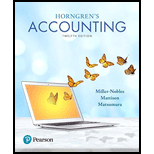
Concept explainers
The Plant-wide overhead allocation rate is computed on the basis of estimated
The Correct Statement based on facts of overhead allocation rate both plant-wide and departmental need to be determined.
Answer to Problem 1QC
Solution: d. The Pre-determined overhead allocation rate is based on actual costs.
Explanation of Solution
The Following statements hold true for the plant-wide and departmental overhead allocation rate:
-The Single Plant-wide overhead rate is computed for the plant by dividing the estimated overheads by the estimated activity level (single activity base must be taken for total estimated overheads). This is the simplest method of overhead allocation to various jobs.
-The departmental overhead allocation rate is computed the same way with the difference being instead of single rate, the different departmental overhead rates must be computed taking activity base of departments (which are primary in each department and vary from department to department). This is refined form of allocation of overheads as each department is having different primary activity base.
Based on above explanation, in the given problem, the following statement regarding the overheads allocation rate shall not hold true:
d. The Pre-determined overhead allocation rate is based on actual costs.
To conclude, it must be said that the Statement (d) does not hold true as the pre-determined overhead rate is based on estimated overheads rather than on actual overhead incurred.
Want to see more full solutions like this?
Chapter 24 Solutions
Horngren's Accounting Plus Mylab Accounting With Pearson Etext -- Access Card Package (12th Edition)
- Please give me true answer this financial accounting questionarrow_forwardRaptors Inc. creates aluminum alloy parts for commercial aircraft. In a recent transaction Raptors leased a high precision lathe machine from Grizzlies Corp. on January 1, 2024. The following information pertains to the leased asset and the lease agreement: Cost of lathe to lessor $140,000 Grizzlies normal selling price for lathe 178,268 Useful life 7 years Estimated value at end of useful life 8,000 Lease provisions Lease term 5 years Payment frequency Annual Start date of lease January 1 Payment timing December 31 Estimated residual value at end of lease (unguaranteed) 20,000 Interest rate implicit in the lease (readily determinable by lessee) 7% Lessee's incremental borrowing rate 8% The lathe machine will revert back to the lessor at end of lease term, title does not transfer to lessee at any time, and there is not a bargain purchase option. Required…arrow_forwardFinancial Accountingarrow_forward
- Can you please solve this financial accounting problem without use Ai?arrow_forwardHobbiton Tours Ltd. has the following details related to its defined benefit pension plan as at December 31, 2024: Pension fund assets of $1,900,000 and actuarial obligation of $1,806,317. The actuarial obligation represents the present value of a single benefit payment of $3,200,000 that is due on December 31, 2030, discounted at an interest rate of 10%; i.e. $3,200,000 / 1.106 = $1,806,317. Funding during 2025 was $55,000. The actual value of pension fund assets at the end of 2025 was $2,171,000. As a result of the current services received from employees, the single payment due on December 31, 2030, had increased from $3,200,000 to $3,380,000. Required Compute the current service cost for 2025 and the amount of the accrued benefit obligation at December 31, 2025. Perform this computation for an interest rate of 8%. Derive the pension expense for 2025 under various assumptions about the expected return and discount rate. Complete the following table: Case…arrow_forwardCalculate Debt Ratios and Debt to Equity Ratio for 2016arrow_forward
- Please explain the correct approach for solving this financial accounting question.arrow_forwardIn 2026, Maple Leafs Co. sells its single machine, which cost $100,000 and has an undepreciated capital cost (UCC) of $25,000 for tax purposes. For financial reporting, the machine has carrying amount of $40,000. The sale price of the machine is $30,000. Aside from the sale of the machine, the company has other income (before taxes) of $600,000, which includes non-taxable dividends of $120,000 dollars received during the year. There are no other permanent or temporary differences. The company faces an income tax rate of 35%. Required Provide the journal entries for the company for 2026.arrow_forwardBlue Jays Corporation started operations on March 1, 2025. It needs to acquire a special piece of equipment for its manufacturing operations. It is evaluating two options as follows. Option 1: Lease the equipment for 5 years. Lease payments would be $11,000 per year, due at the beginning of each fiscal year (March 1). Blue Jays incremental borrowing rate is 5%. There is not a bargain purchase or renewal option. Blue Jays is responsible for all non-lease costs of operating the equipment. Option 2: Purchase the equipment for $50,000 by borrowing the full purchase amount at 5% over 5 years. This price is considered the fair value of the equipment. Payments are due at the end of each fiscal year (February 28). The equipment has a useful life of 5 years and would be depreciated on a straight-line basis. No residual value is expected to exist at the end of 5 years. Required Calculate the present value of the lease payments (Option 1). Calculate the payment that would be…arrow_forward

 AccountingAccountingISBN:9781337272094Author:WARREN, Carl S., Reeve, James M., Duchac, Jonathan E.Publisher:Cengage Learning,
AccountingAccountingISBN:9781337272094Author:WARREN, Carl S., Reeve, James M., Duchac, Jonathan E.Publisher:Cengage Learning, Accounting Information SystemsAccountingISBN:9781337619202Author:Hall, James A.Publisher:Cengage Learning,
Accounting Information SystemsAccountingISBN:9781337619202Author:Hall, James A.Publisher:Cengage Learning, Horngren's Cost Accounting: A Managerial Emphasis...AccountingISBN:9780134475585Author:Srikant M. Datar, Madhav V. RajanPublisher:PEARSON
Horngren's Cost Accounting: A Managerial Emphasis...AccountingISBN:9780134475585Author:Srikant M. Datar, Madhav V. RajanPublisher:PEARSON Intermediate AccountingAccountingISBN:9781259722660Author:J. David Spiceland, Mark W. Nelson, Wayne M ThomasPublisher:McGraw-Hill Education
Intermediate AccountingAccountingISBN:9781259722660Author:J. David Spiceland, Mark W. Nelson, Wayne M ThomasPublisher:McGraw-Hill Education Financial and Managerial AccountingAccountingISBN:9781259726705Author:John J Wild, Ken W. Shaw, Barbara Chiappetta Fundamental Accounting PrinciplesPublisher:McGraw-Hill Education
Financial and Managerial AccountingAccountingISBN:9781259726705Author:John J Wild, Ken W. Shaw, Barbara Chiappetta Fundamental Accounting PrinciplesPublisher:McGraw-Hill Education





